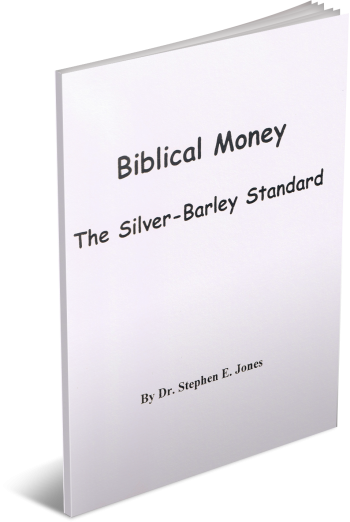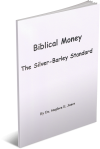Latest Posts
View the latest posts in an easy-to-read list format, with filtering options.

This is a 34-page primer that shows the difference between the monetary system of Babylon and that of the Kingdom.
Category - General

In the past, barter was the most common form of exchange for goods and services. In fact, whether workers get paid in silver or in potatoes is somewhat irrelevant. Whether a man buys something with gold, paper, or chickens, it is still called “trade.” It is an exchange of equal value. Labor may be exchanged for silver, wheat, or currency—whatever is the agreement. The point is that anything that has value is money, though we have more recently invented something called currency.
Currency issued by a private party is a paper IOU, an agreement or contract to pay something. It can be payable in anything that has value to the one who redeems it. Value is determined by the amount of goods and services a person can receive by redeeming the note from its issuer. Such IOU notes could be passed from person to person, as long as men had faith that it was backed by the issuer at any time.
In other words, that IOU functioned as currency as long as it circulated among the people. But ultimately, its value depended on the ability of the issuer to give valued goods to whoever redeemed it from the original issuer. Meanwhile, though, while in circulation, its value was evident by the fact that anyone could trade it for goods and services.
In recent years we have largely stopped thinking in terms of barter, even though economists still use the term “trade” to denote business transactions. We no longer think of bartering, because currency is no longer issued by private parties but by governments (including the Fed, which is an unofficial government in itself).
It used to be that private banks issued paper currency. If someone brought $100 worth of gold coins to the bank, the bank would issue a “note” to the depositor as a receipt. The note stated that the bank owed $100 in gold to whoever wanted to redeem the note.
The notes would then circulate among the people, because the gold in the bank gave the note value. As long as the people had confidence that the bank really could exchange gold for the note, most of the notes remained in circulation. It was only when the bankers became greedy that problems arose. They realized that as long as no one knew how many notes they were issuing and how much gold could back those notes, they could create extra bank notes and use them to buy genuine wealth—goods and services.
Of course, invariably, the people would discover what the banker was doing, and suddenly there was run on the bank. The bank could not redeem all the notes in gold, and so most people were left with worthless bank notes—empty promises to pay. It was theft.
In such cases, it did not matter if the bank created notes on gold, silver, wheat, or tobacco. The problem was not the type of wealth that the bank note represented. The problem was fractional banking—lending more currency (or credit) than what was actually backed by the bank assets.
This brings us to today’s problem, where the Federal Reserve creates credit or currency. Banks multiply it by fractional banking. The net effect is largely the same in an economy, but there is a difference. A bank can only multiply something that it already lists as an asset. But currency since 1914 originates with the Federal Reserve Bank.
The two main duties of government should be to defend the nation and to create currency. It is for the people themselves to create money, if we understand the distinction between money and currency. Currency should not be issued by private banks, nor even by privately-owned central banks.
The Federal Reserve Act did indeed solve the confusion of too many small banks issuing their own bank notes. If a man had money from the bank of Vermont, but wished to travel to Georgia, the shopkeeper in Georgia had no easy way of knowing if the Vermont bank notes had real value. This tended to restrict trade and commerce over long distances.
So the advantages of having a single federal currency are obvious. This was the argument used to sell the idea of creating the Federal Reserve Bank. The problem was not the bank itself, but the ownership of the bank. It pretended to be “federal,” when in fact it was privately owned. This fraud allowed a small elite group of central bankers to hold the purse strings of the nation and thereby control its politics.
The right to create and issue currency should reside exclusively with government. This is apparently what the framers of the American Constitution had in mind when they listed among the duties of Congress: “to coin Money, regulate the Value thereof, and of foreign Coin, and fix the standard of Weights and Measures” (Article 1, Sec. 8, par. 5). The coinage of “money” is the key phrase here.
Benjamin Franklin insisted upon this provision. But he died April 17, 1790, shortly after its ratification. Alexander Hamilton was able to convince Congress to establish the first private “National Bank” on Feb. 25, 1791.
Not until the time of Abraham Lincoln did government actually issue its own currency in America for the first time. His currency was called the Greenback, because it had green ink on the back side. For the first time, the right to create currency was taken out of private hands and put where it belonged constitutionally.
Bankers do not like backing their currency with wheat or tobacco. Such things must be periodically consumed, because they do not last forever. They also have natural enemies such as rats and floods. And so, for practical reasons, bankers prefer gold and silver. It is natural, then, for bankers to accumulate gold and silver, and when they set up a bank, they back their currency with these assets.
When this happens, it tends to increase the value of whatever is backing the currency. The bank owners, then, are the primary beneficiaries, because their own assets enjoy an increase in value. In fact, a private bank must be backed by the assets of the private banker.
But when currency is issued by government, it becomes a national currency and does not need to be backed merely by gold or silver. It is backed by all the assets of the nation itself—the productivity, mind and labor, of the entire population and work force. The entire gross national product is the money (wealth) that backs the currency.
Currency then is more easily exchanged for virtually anything of value, not simply gold or silver, and its supply is not limited to the amount of any single item of value in the nation. If someone wants to exchange their currency for gold, they need not go to a federal bank to get it. They may simply buy it on the open market, because all currency is backed by the people who are willing to sell a product.
Currency is a paper that represents someone's labor. In other words, true currency is a receipt for labor, which you may trade for the products of someone else's labor. That is honest currency. It is not a debt-note, because its backing has already been produced. Trading in such notes is not a matter of paying off IOU’s, nor does it treat debts as assets. It is a means of exchanging one form of wealth for another. When the amount of money in circulation equals the amount of wealth that has already been produced, then it is not a debt but a check that can be drawn on a storehouse of wealth in every marketplace.
Yet many people say that money should be backed by gold (or silver), and they trace all of our monetary problems to the lack of any substantial gold backing. No, the problem is that the currency is now backed by government bonds (debts), rather than by the goods and services of the people.
Problem #1. Modern currency is created by private banks and loaned to the government at interest.
Problem #2. The Federal Reserve Bank, which acts as if it were a federal institution, relies upon the faith and credit of the United States to back its money. Their notes today are not backed by any wealth in the bank, because these Notes are no longer bank IOU’s which men may return to the bank in exchange for wealth. Instead, they are IOU’s that the government owes for the privilege of using currency that banks created out of nothing and backed by nothing but more of the same. To reduce government debt, they must buy back the debt-bonds that they have issued.
But to reduce the debt would mean removing that amount of “money” from circulation. This, in turn, would cause a recession. Theoretically, if the entire debt were repaid, all “money” would be removed from circulation—but because of the interest already accumulated, the government would still owe trillions of dollars on the national debt.
Such a debt-money system is unsustainable. It only works as long as enough people take out enough loans to create enough “money” to cover the interest paid back to the banks each year. In 2007, however, the perfect storm struck the world financial system. Housing prices stopped going up, Americans could not repay mortgages, and credit froze. Suddenly, there was not enough new money being created to sustain the economy, and it began to collapse.
All of this could have been avoided long ago, if honest currency had been created, instead of bonds (debt notes). If government had retained its right to create currency rather than bonds, there would be no national debt. Currency would simply be created as needed and would circulate as a medium of exchange to facilitate long-distance trade.
It therefore remains to us to study Kingdom Economics, so that when the present system destroys itself, we will have some idea how to replace it with a system that benefits the wealth-producers, rather than the debt-creators.